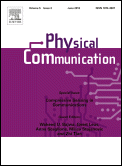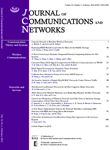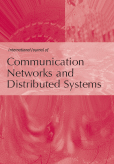
Physical Communication
Scope & Guideline
Elevating Standards in Communication Research
Introduction
Aims and Scopes
- Wireless Communication Technologies:
The journal explores various technologies underpinning wireless communication, including 5G, 6G, and beyond, with a focus on their applications, challenges, and future directions. - Signal Processing and Modulation Techniques:
A significant emphasis is placed on advanced signal processing methods, modulation techniques, and their optimization for enhancing communication systems' performance. - Machine Learning and AI in Communication:
The integration of artificial intelligence and machine learning techniques into communication systems is a core area, focusing on resource allocation, signal detection, and network optimization. - Cognitive Radio and Spectrum Management:
Research on cognitive radio networks, spectrum sensing, and dynamic spectrum access is prevalent, addressing the efficient use of available spectrum resources. - Network Architecture and Design:
The journal covers various network architectures, including mobile edge computing, UAV networks, and IoT, with a focus on their design, scalability, and performance under different conditions. - Physical Layer Security:
Ensuring secure communication through physical layer techniques is a vital area of investigation, addressing vulnerabilities in communication systems. - Energy Efficiency and Sustainability:
Research on energy-efficient communication strategies, especially in the context of green communications and sustainable network designs, is increasingly prominent.
Trending and Emerging
- Reconfigurable Intelligent Surfaces (RIS):
The integration of RIS in communication systems is rapidly gaining attention for its potential to enhance signal quality and coverage while reducing energy consumption. - Non-Orthogonal Multiple Access (NOMA):
NOMA is emerging as a key technology for improving spectral efficiency, especially in scenarios with high user density, making it a focus of recent research. - Machine Learning for Resource Management:
The application of machine learning techniques for optimizing resource allocation and network management is a prominent trend, reflecting the growing interest in AI-driven solutions. - UAV-Assisted Communications:
Research on UAVs for communication purposes is on the rise, particularly in emergency response scenarios and the Internet of Things, highlighting their versatility and effectiveness. - Energy Harvesting Technologies:
The integration of energy harvesting solutions in communication networks is becoming increasingly important, especially for sustainable and eco-friendly network designs. - Physical Layer Security Advances:
There is a strong trend towards enhancing security at the physical layer, with innovative techniques being developed to protect against eavesdropping and other vulnerabilities.
Declining or Waning
- Traditional Communication Protocols:
There is a noticeable decline in the publication of papers focused on older communication protocols as researchers shift towards more advanced and adaptive protocols suitable for modern applications. - Basic Modulation Schemes:
Research on fundamental modulation techniques, such as QPSK and BPSK, has decreased as the focus shifts to more complex schemes that offer better performance in dense and challenging environments. - Static Network Models:
The interest in static or traditional network models is waning as dynamic and adaptive models that account for mobility and changing conditions gain prominence. - Legacy Wireless Technologies:
Research on legacy wireless technologies, such as 2G and 3G, is diminishing as the focus shifts towards next-generation technologies like 5G and beyond. - Heuristic Optimization Methods:
While optimization remains a critical area, the reliance on traditional heuristic methods is decreasing in favor of more sophisticated machine learning-based approaches.
Similar Journals

JOURNAL OF COMMUNICATIONS AND NETWORKS
Advancing the Frontiers of Communication and NetworkingJOURNAL OF COMMUNICATIONS AND NETWORKS, published by the Korean Institute of Communications Sciences (KICS), is a leading academic journal that has been at the forefront of the fields of Computer Networks and Communications as well as Information Systems since its inception in 1999. With a strong commitment to advancing research in these critical areas, this journal has achieved a prestigious Q1 ranking in both domains as of 2023, reflecting its significant impact and innovative contributions to the field. The journal features original research, review articles, and technical notes that address the latest advancements in communication technologies, network architecture, and data management strategies. As a vital resource for researchers, practitioners, and students, it not only disseminates valuable findings but also fosters collaboration and knowledge exchange among diverse disciplines within the communications landscape. With a consistent annual volume, the journal continues to shape the future of communications science and offers authors an esteemed platform to showcase their work.

EURASIP Journal on Advances in Signal Processing
Empowering Research in Electrical Engineering and Beyond.EURASIP Journal on Advances in Signal Processing, published by Springer, is a premier open-access journal that has been at the forefront of research in the field of signal processing since its inception in 2001. With a focus on advancing the disciplines of Electrical Engineering, Hardware and Architecture, and Signal Processing, this journal plays a crucial role in disseminating innovative findings and facilitating collaboration among academics and industry professionals. Ranking in Q2 for Electrical and Electronic Engineering and Q3 in both Hardware and Architecture and Signal Processing as per the 2023 category quartiles, it highlights the journal's commitment to high-quality research. The journal is indexed in Scopus, reflecting its reputable standing within the global research community. Researchers, professionals, and students are invited to contribute to and benefit from the wealth of knowledge and advancements presented in each issue, furthering their understanding and application of state-of-the-art signal processing techniques.

TELECOMMUNICATION SYSTEMS
Fostering Collaboration in the Telecommunications LandscapeTelecommunication Systems is a premier academic journal published by Springer, dedicated to advancing the field of telecommunications and information systems. With an ISSN of 1018-4864 and an E-ISSN of 1572-9451, this journal has established itself as a crucial resource in the realms of Electrical and Electronic Engineering, evidenced by its esteemed ranking in the Q2 category and a 70th percentile standing in Scopus ranks. Since its inception in 1993, it has provided an important platform for original research, innovative solutions, and theoretical developments in telecommunications technologies. The journal's objectives include fostering interdisciplinary collaboration and exploring the latest advancements in communication systems, making it essential reading for researchers, professionals, and students alike. With its commitment to quality and relevance, Telecommunication Systems remains at the forefront of scholarly communication in the dynamic telecommunications sector.

ICT Express
Leading the Charge in Cutting-edge ICT ResearchICT Express is a leading open-access journal published by Elsevier that has established itself at the forefront of the fields of Artificial Intelligence, Computer Networks and Communications, Hardware and Architecture, Information Systems, and Software. Since its inception in 2015, this South Korea-based journal has provided a vital platform for disseminating innovative research and practical applications across these rapidly evolving domains. With an impressive impact factor and consistently high Scopus rankings—placing it in the top quartiles of its categories—it attracts contributions from both seasoned experts and emerging scholars. Current access options ensure that groundbreaking findings are readily available to a global audience, thus fostering collaboration and advancement in technology and computational sciences. As ICT continues to reshape various industries, the significance of research published in ICT Express is crucial for staying ahead in the digital landscape.

Annals of Telecommunications
Bridging theory and practice in telecommunications excellence.Annals of Telecommunications is a prestigious peer-reviewed journal published by SPRINGER INT PUBL AG, dedicated to advancing the field of electrical and electronic engineering. Established in 1946, this journal presents a comprehensive collection of research articles that address the latest trends and developments in telecommunications, including innovative technologies, systems, and applications. With an impressive Q2 ranking in the 2023 category of Electrical and Electronic Engineering and a Scopus rank in the 68th percentile, the journal serves as a vital platform for researchers, professionals, and students looking to disseminate groundbreaking findings and engage with contemporary challenges in the field. Although it is not an Open Access journal, it offers a wealth of knowledge that contributes to both academic and practical advancements in telecommunications. The Annals of Telecommunications remains an essential resource for anyone involved in telecommunication research and practice, fostering collaboration and knowledge exchange globally.

ELECTRONICS LETTERS
Connecting Ideas, Shaping Technology.ELECTRONICS LETTERS, published by WILEY, is a leading peer-reviewed journal dedicated to the field of Electrical and Electronic Engineering. With a rich history dating back to 1965, this journal serves as a prominent platform for disseminating novel research and innovations in electronics, covering topics such as circuit design, telecommunications, and signal processing. In 2021, the journal transitioned to an Open Access format, ensuring that cutting-edge research is freely accessible to a global audience, thereby enhancing its impact and outreach. The journal currently holds a Q3 quartile ranking in its category, reflecting its solid position among its peers, and ranks #451 out of 797 in Scopus for Electrical and Electronic Engineering, placing it within the 43rd percentile. ELECTRONICS LETTERS is essential for researchers, professionals, and students looking to stay abreast of the latest developments and contribute to advancements in the field, fostering collaboration and knowledge sharing in a rapidly evolving landscape.

Radioengineering
Advancing the frontiers of radioengineering research.Radioengineering is a prominent academic journal published by SPOLECNOST PRO RADIOELEKTRONICKE INZENYRSTVI, focusing on the fields of electrical and electronic engineering. Established in 1992, this open access journal aims to disseminate high-quality research and innovative developments in radioengineering and related disciplines. With an inclusive readership from around the world, it has been integral in fostering advancements in technologies such as wireless communication, signal processing, and electromagnetic theory. The journal's commitment to accessibility is underscored by its open access policy, allowing scholars and practitioners to freely engage with the latest findings. As of 2023, *Radioengineering* holds a Q3 quartile ranking in its field with a Scopus rank of #500/797, placing it within the 37th percentile among its peers. Researchers, professionals, and students engaged in electrical and electronic engineering will find *Radioengineering* an essential resource for both theoretical insights and practical applications. For further information, submissions, and access to articles, please visit the journal’s site linked through the CZECH TECHNICAL UNIVERSITY, located in Prague, Czech Republic.

IEEE Open Journal of the Communications Society
Advancing the Frontiers of Communication ResearchWelcome to the IEEE Open Journal of the Communications Society, a premier open-access publication dedicated to advancing the fields of computer networks and communications. Launched in 2020 by the esteemed IEEE-Institute of Electrical and Electronics Engineers, this journal operates under a commitment to disseminate high-quality, peer-reviewed research that fosters innovation and collaboration within the global communications community. With an impressive impact factor and currently positioned in the Q1 category of Time's rankings for Computer Networks and Communications (2023), the journal ranks 21st out of 395 in its field, placing it within the top 6% globally. It serves as a vital forum for researchers, professionals, and students, providing them with immediate access to pioneering studies and emerging trends. Being fully open access, all published articles are freely available to enhance the reach and impact of your research. Join us in exploring transformative ideas and technologies that shape the future of communications.

International Journal of Communication Networks and Distributed Systems
Connecting Research with Real-World ApplicationsInternational Journal of Communication Networks and Distributed Systems is a prestigious academic platform dedicated to the exploration and advancement of research in the realms of communication networks and distributed systems. Published by INDERSCIENCE ENTERPRISES LTD in the scenic locale of Switzerland, this journal aims to bridge the gap between theoretical innovations and practical applications, catering to a diverse audience of researchers, professionals, and students. With an ISSN of 1754-3916 and an E-ISSN of 1754-3924, it has established itself as a valued resource in its field, currently ranking in the Q3 category in Computer Networks and Communications according to the latest metrics. The journal's commitment to fostering high-quality research is underscored by its convergence of studies from 2008 to 2024. Though it operates under traditional access, it encourages a wide dissemination of knowledge, emphasizing the importance of ongoing dialogue in advancing communication technologies. As technology continues to evolve, the International Journal of Communication Networks and Distributed Systems remains a critical forum for insights, best practices, and innovations that shape the future of digital communication.

Frontiers in Communications and Networks
Exploring the Nexus of Networks and Signal ProcessingFrontiers in Communications and Networks is a prominent open-access journal published by FRONTIERS MEDIA SA, established in 2020 and positioned in the heart of Switzerland. As an interdisciplinary platform, it focuses on advancing research related to computer networks, communications, and signal processing, providing a critical forum for innovative findings and developments in these rapidly evolving fields. With an impressive Q1 ranking in Computer Networks and Communications and a Q2 ranking in Signal Processing as of 2023, this journal is highly regarded among scholars and practitioners seeking to disseminate their work to a broad audience. By offering open-access options, it ensures that the research is widely available, fostering collaboration and knowledge sharing across the globe. Researchers, professionals, and students are encouraged to engage with the journal as it aims to encapsulate the burgeoning advancements shaping our digital communication landscape.